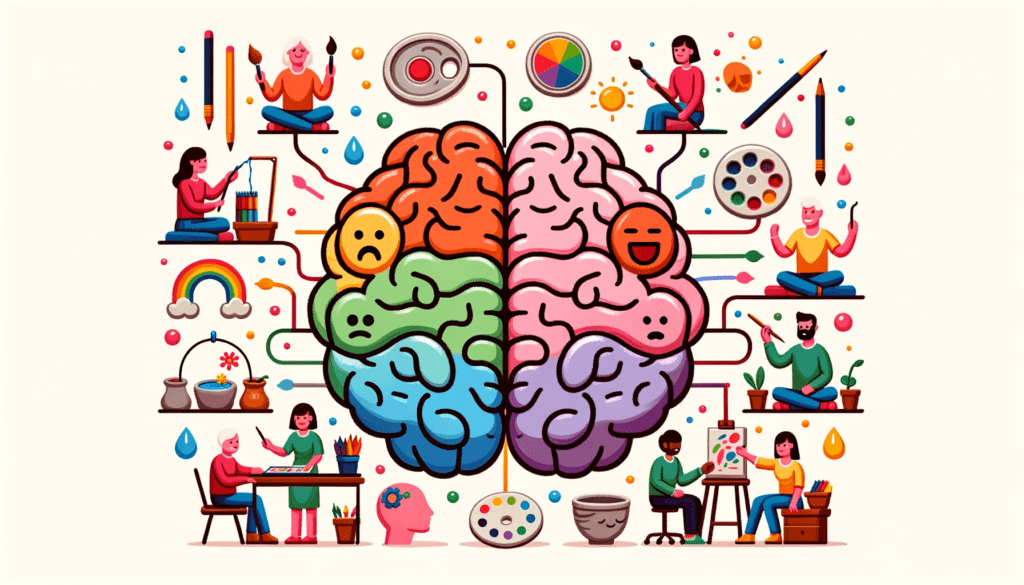Introduction
Imagine transforming your deepest emotions, confronting haunting memories, and expressing your innermost feelings—all by merely moving a paintbrush or molding a piece of clay. Art has been the voice of the soul for millennia, and in our modern age, it has evolved into a therapeutic tool. The power of art therapy in mental health is profound, helping countless individuals find healing, expression, and peace.
What is Art Therapy?
Art therapy isn’t just about creating pretty pictures. It’s a form of psychotherapy that utilizes art creation as its primary mode of communication. Historically, art therapy’s roots can be traced back to the early 20th century, where psychiatrists began to notice the emotional release and expressive qualities art brought to their patients. The American Art Therapy Association reports numerous benefits of art therapy, from improved cognitive function to reduced stress.
For example, Jane, a 32-year-old teacher, battled depression for years. Traditional therapy had its merits, but it was only when she discovered art therapy that she found a unique way to confront and communicate her feelings. Through her artwork, she depicted her journey, and each piece became a testament to her resilience and growth.
Read: What Are 5 Signs of Mental Health Problems
Art Therapy Vs. Traditional Therapy

While traditional talk therapy has its place in mental health, art therapy offers a distinctive approach. Unlike verbal communication, art allows for abstract expression, providing a medium to convey what might be too painful or challenging to articulate with words.
Consider Mark, a war veteran. He struggled with PTSD and found it hard to describe his traumas verbally. However, through art therapy, he painted vivid scenes of his experiences, which not only gave him an outlet but also provided his therapist with insights into his psyche.
Who Can Benefit From Art Therapy?
Art therapy isn’t limited by age or condition. Whether you’re a teenager grappling with identity issues, an adult facing anxiety, or an elderly individual dealing with the challenges of aging, there’s a place for you in the colorful world of art therapy.
Sarah, a 10-year-old, used art therapy to cope with her parents’ divorce. Through drawings, she communicated her fears, hopes, and confusions, helping her therapist guide her through the emotional maze. Meanwhile, Raj, a 60-year-old retiree, turned to pottery as part of his art therapy. The act of molding clay became a metaphor for reshaping his life post-retirement.
The Science Behind Art Therapy
Art isn’t just a form of expression; it’s a neural activity powerhouse. Creating art stimulates the brain in unique ways, different from merely viewing art. Neuroscientific studies have shown that art creation activates the brain’s reward pathways, releasing dopamine, the “feel-good” neurotransmitter.
Furthermore, the colors you choose, the shapes you create, and the textures you employ all have psychological implications. For instance, blue hues are often linked with calmness and serenity, while angular shapes might indicate tension or conflict. Read What Are the 4 Types of Mental Health.
Art Therapy Exercises for Mental Health
Painting Exercises
- Abstract Emotion Painting: This isn’t about creating a masterpiece but expressing your current emotional state. Feeling blue? Splash it on the canvas. Angry? Let fiery reds and oranges dominate.
- Self-portrait Exploration: Paint yourself. Not your physical self, but the inner you. How do you perceive yourself? This can be an enlightening experience, revealing self-perceptions and aspirations.
Drawing Exercises
- Dream Journaling: Maintain a journal. Each morning, sketch out any dreams or fragments you remember. Over time, you might decipher patterns or recurring symbols, providing insights into your subconscious.
- Mindful Doodling: Switch off your brain and let your hand move freely. It’s meditative and can be a great stress buster.
Sculpture & Clay Exercises
- Create Your “Safe Space”: Sculpt your ideal sanctuary, a place where you feel completely at peace.
- Emotion Masks: Craft masks representing different emotions. This can be an enlightening way to externalize and confront complex feelings.
Collage & Mixed Media Exercises
- Vision Boards: Use magazine cut-outs, photos, and any other materials to create a board of your aspirations and dreams.
- Memory Collages: Assemble a collage of your most cherished memories, helping you reconnect with joyful moments.
Digital Art Exercises
- Digital Self-portraits: Using digital tools, create a self-portrait, experimenting with styles and colors.
- Animated Emotion Gifs: Design a series of gifs, each representing a different emotion.
Implementing Art Therapy at Home
Starting with art therapy doesn’t require a fancy studio. A quiet corner, some basic supplies, and an open mind are all you need. Remember, the goal isn’t perfection but expression. Let go of judgments, embrace mistakes, and allow your emotions to flow onto your chosen medium. The journey of self-discovery through art is more rewarding than the destination.
Finding a Professional Art Therapist
If you’re looking to dive deeper into art therapy, consider seeking a certified art therapist. They’re trained to guide you through the therapeutic art process, ensuring you reap the maximum benefits. Websites like the Art Therapy Credentials Board can help you find qualified professionals in your area.
Conclusion
Art therapy transcends traditional therapeutic boundaries, offering a world where emotions take color, shape, and form. It’s a realm where the soul speaks in strokes and shades. As you embark on this journey, remember that every piece you create is a step towards healing, understanding, and self-discovery.
Read: What Are the 5 Parts of Mental Health
References
- American Art Therapy Association. (2018). Benefits of Art Therapy.
- Neuroscientific studies on art and the brain. (2019). Journal of Art and Neuroscience.
- Art Therapy Credentials Board. (2020). Finding a Certified Art Therapist.

